A team of scientists, led by researchers from the Universidad de Alcalá (UAH) and the Universitat Autònoma de Barcelona (UAB), has discovered and analyzed the first direct evidence of basketry among nomadic hunter-gatherers and initial farming communities in southern Europe, specifically within the Cueva de los Murciélagos in Albuñol, Granada, Spain.
Their research, which was recently published in the journal Science Advances, analyzed 76 artifacts crafted from natural materials like wood, reed, and esparto. These items were originally found during mining operations in the 19th century within the aforementioned cave in Granada.
The researchers studied the raw materials and technology and carried out carbon-14 dating, which revealed that the set dates to the early and middle Holocene period, between 9,500 and 6,200 years ago. This is the first direct evidence of basketry made by Mesolithic hunter-gatherer societies in southern Europe and a unique set of other organic tools associated with early Neolithic farming communities, such as sandals and a wooden mace.
Rethinking Prehistoric Technologies
As researcher of the Prehistory Department of the University of Alcalá Francisco Martínez Sevilla explains, “The new dating of the esparto baskets from the Cueva de los Murciélagos of Albuñol opens a window of opportunity to understanding the last hunter-gatherer societies of the early Holocene. The quality and technological complexity of the basketry makes us question the simplistic assumptions we have about human communities prior to the arrival of agriculture in southern Europe. This work and the project that is being developed places the Cueva de los Murciélagos as a unique site in Europe to study the organic materials of prehistoric populations.”
Cueva de los Murciélagos: A Unique Prehistoric Site
Cueva de los Murciélagos is located on the coast of Granada, to the south of the Sierra Nevada and 2 kilometers from the town of Albuñol. The cave opens on the right side of the Barranco de las Angosturas, at an altitude of 450 meters above sea level and about 7 kilometers from the current coastline.
It is one of the most emblematic prehistoric archaeological sites of the Iberian Peninsula due to the rare preservation of organic materials, which until this study had only been attributed to the Neolithic.
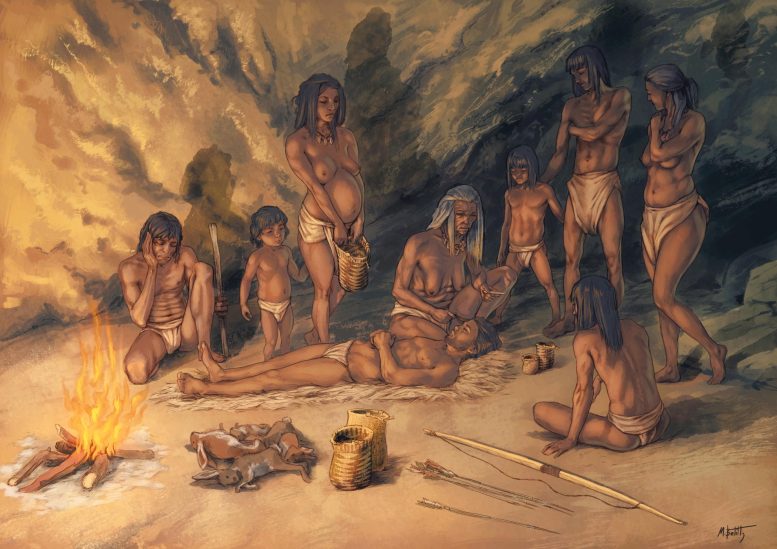
Artistic recreation of the use of Mesolithic baskets by a group of hunter-gatherers in the Cueva de los Murciélagos de Albuñol. Credit: Moisés Belilty Molinos, with the scientific supervision of Francisco Martínez-Sevilla and Maria Herrero-Otal
The objects made of perishable materials were discovered by the mining activities of the 19th century and were documented and recovered by Manuel de Góngora y Martínez, later becoming part of the first collections of the National Archaeological Museum of Madrid.
Ancient Mastery of Plant Fibers
As detailed by María Herrero Otal, co-author of the work and researcher at the Universitat Autònoma de Barcelona, “the esparto grass objects from Cueva de los Murciélagos are the oldest and best-preserved set of plant fiber materials in southern Europe so far known. The technological diversity and the treatment of the raw material documented demonstrates the ability of prehistoric communities to master this type of craftsmanship, at least since 9,500 years ago, in the Mesolithic period. Only one type of technique related to hunter-gatherers has been identified, while the typological, technological, and treatment range of esparto grass was extended during the Neolithic from 7,200 to 6,200 years before the present.”
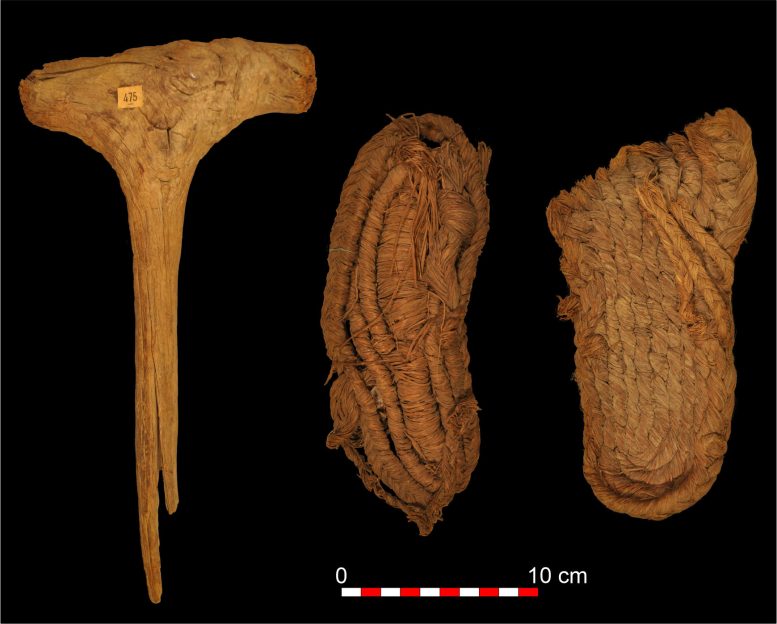
Wooden mace and esparto sandals, dating back to the Neolithic 6,200 years ago (right). Credit: MUTERMUR Project
The work is part of the project “De los museos al territorio: actualizando el estudio de la Cueva de los Murciélagos de Albuñol (Granada)” (MUTERMUR), which has been funded by the Community of Madrid and the Universidad de Alcalá.
The objective of this project is the holistic study of the site and its material record, applying the latest archaeometric techniques and generating quality scientific data. The project also included the collaboration of the National Archaeological Museum, the Archaeological and Ethnological Museum of Granada, the City Council of Albuñol, and the owners of the cave.
“The results of this work and the finding of the oldest basketry in southern Europe give more meaning, if possible, to the phrase written by Manuel de Góngora in his work Prehistoric Antiquities of Andalusia (1868): ‘the now forever famous Cueva de los Murciélagos,’” the authors highlight.
Reference: “The earliest basketry in southern Europe: Hunter-gatherer and farmer plant-based technology in Cueva de los Murciélagos (Albuñol)” by Francisco Martínez-Sevilla, Maria Herrero-Otal, María Martín-Seijo, Jonathan Santana, José A. Lozano Rodríguez, Ruth Maicas Ramos, Miriam Cubas, Anna Homs, Rafael M. Martínez Sánchez, Ingrid Bertin, Rosa Barroso Bermejo, Primitiva Bueno Ramírez, Rodrigo de Balbín Behrmann, Antoni Palomo Pérez, Antonio M. Álvarez-Valero, Leonor Peña-Chocarro, Mercedes Murillo-Barroso, Eva Fernández-Domínguez, Manuel Altamirano García, Rubén Pardo Martínez, Mercedes Iriarte Cela, Javier L. Carrasco Rus, Carmen Alfaro Giner and Raquel Piqué Huerta, 27 September 2023, Science Advances.
DOI: 10.1126/sciadv.adi3055
In addition to Francisco Martínez Sevilla and María Herrero Otal, specialists from different disciplines such as Prehistory, Geology, Physics-Chemistry, Carpology or Anthracology participated in this interdisciplinary study: María Martín-Seijo (Universidad de Cantabria); Jonathan Santana (Universidad de Las Palmas de Gran Canaria); José A. Lozano Rodríguez (Oceanographic Center of the Canary Islands); Ruth Maicas Ramos (National Archaeological Museum); Miriam Cubas, Rosa Barroso Bermejo, Primitiva Bueno Ramírez and Rodrigo de Balbín Behrmann (Universidad de Alcalá); Anna Homs; Rafael M. Martínez Sánchez (Universidad de Córdoba) Ingrid Bertin (Université Côte d’Azur); Antonio M. Álvarez-Valero (Universidad de Salamanca); Leonor Peña Chocarro (Instituto de Historia, Consejo Superior de Investigaciones Científicas); Javier L. Carrasco Rus, Rubén Pardo Martínez and Mercedes Murillo Barroso (Universidad de Granada); Eva Fernández Domínguez (Durham University); Manuel Altamirano García (Universidad a Distancia); Mercedes Iriarte Cela (Centro Tecnológico y de Investigación SDLE); Carmen Alfaro Giner (Universitat de València); Antoni Palomo Pérez and Raquel Piqué Huerta (Universitat Autònoma de Barcelona).

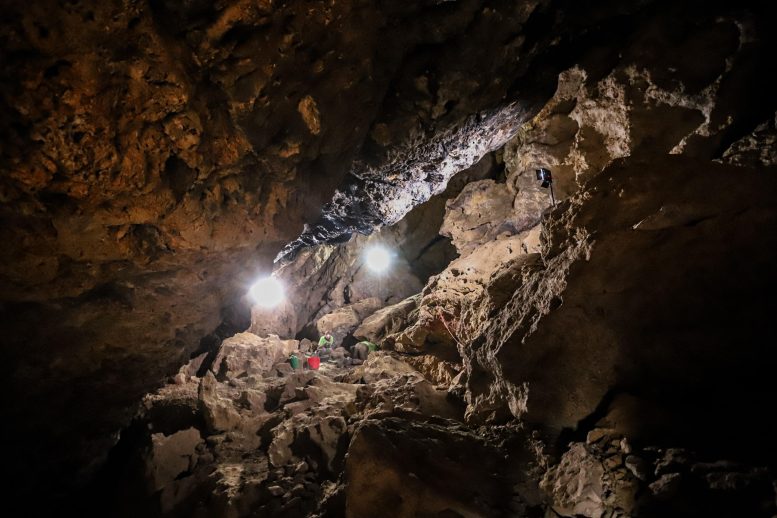
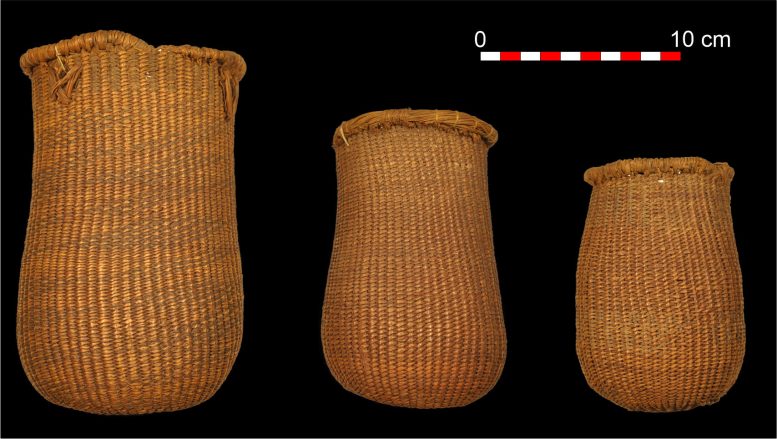



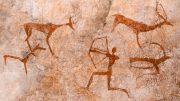




Be the first to comment on "Rewriting History: New Discoveries Challenge Assumptions About Pre-Agricultural Societies in Europe"